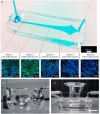Polymeric and biological membranes for organ-on-a-chip devices
- PMID: 37649779
- PMCID: PMC10462672
- DOI: 10.1038/s41378-023-00579-z
Polymeric and biological membranes for organ-on-a-chip devices
Abstract
Membranes are fundamental elements within organ-on-a-chip (OOC) platforms, as they provide adherent cells with support, allow nutrients (and other relevant molecules) to permeate/exchange through membrane pores, and enable the delivery of mechanical or chemical stimuli. Through OOC platforms, physiological processes can be studied in vitro, whereas OOC membranes broaden knowledge of how mechanical and chemical cues affect cells and organs. OOCs with membranes are in vitro microfluidic models that are used to replace animal testing for various applications, such as drug discovery and disease modeling. In this review, the relevance of OOCs with membranes is discussed as well as their scaffold and actuation roles, properties (physical and material), and fabrication methods in different organ models. The purpose was to aid readers with membrane selection for the development of OOCs with specific applications in the fields of mechanistic, pathological, and drug testing studies. Mechanical stimulation from liquid flow and cyclic strain, as well as their effects on the cell's increased physiological relevance (IPR), are described in the first section. The review also contains methods to fabricate synthetic and ECM (extracellular matrix) protein membranes, their characteristics (e.g., thickness and porosity, which can be adjusted depending on the application, as shown in the graphical abstract), and the biological materials used for their coatings. The discussion section joins and describes the roles of membranes for different research purposes and their advantages and challenges.
Keywords: Materials science; Microfluidics.
© Aerospace Information Research Institute, Chinese Academy of Sciences 2023.
Conflict of interest statement
Competing interestsThe authors declare no competing interests.
Figures









Similar articles
-
Tunable Microstructured Membranes in Organs-on-Chips to Monitor Transendothelial Hydraulic Resistance.Tissue Eng Part A. 2019 Dec;25(23-24):1635-1645. doi: 10.1089/ten.TEA.2019.0021. Epub 2019 Sep 3. Tissue Eng Part A. 2019. PMID: 30957672
-
Integration of Electrospun Membranes into Low-Absorption Thermoplastic Organ-on-Chip.ACS Biomater Sci Eng. 2021 Jul 12;7(7):3006-3017. doi: 10.1021/acsbiomaterials.0c01062. Epub 2021 Feb 16. ACS Biomater Sci Eng. 2021. PMID: 33591723
-
Tiny Organs, Big Impact: How Microfluidic Organ-on-Chip Technology Is Revolutionizing Mucosal Tissues and Vasculature.Bioengineering (Basel). 2024 May 10;11(5):476. doi: 10.3390/bioengineering11050476. Bioengineering (Basel). 2024. PMID: 38790343 Free PMC article. Review.
-
Integration of Extracellular Matrices into Organ-on-Chip Systems.Adv Healthc Mater. 2023 Aug;12(20):e2203256. doi: 10.1002/adhm.202203256. Epub 2023 Apr 29. Adv Healthc Mater. 2023. PMID: 37018430 Free PMC article. Review.
-
Methods of Delivering Mechanical Stimuli to Organ-on-a-Chip.Micromachines (Basel). 2019 Oct 14;10(10):700. doi: 10.3390/mi10100700. Micromachines (Basel). 2019. PMID: 31615136 Free PMC article. Review.
Cited by
-
BioHastalex modified with silver nanolayers and heat treatment for antibacterial properties.Heliyon. 2024 Dec 25;11(1):e41467. doi: 10.1016/j.heliyon.2024.e41467. eCollection 2025 Jan 15. Heliyon. 2024. PMID: 39834419 Free PMC article.
-
Vascularized platforms for investigating cell communication via extracellular vesicles.Biomicrofluidics. 2024 Sep 23;18(5):051504. doi: 10.1063/5.0220840. eCollection 2024 Sep. Biomicrofluidics. 2024. PMID: 39323481 Review.
-
Agarose as a Tissue Mimic for the Porcine Heart, Kidney, and Liver: Measurements and a Springpot Model.Bioengineering (Basel). 2024 Jun 8;11(6):589. doi: 10.3390/bioengineering11060589. Bioengineering (Basel). 2024. PMID: 38927825 Free PMC article.
-
Developments and Applications of Liver-on-a-Chip Technology-Current Status and Future Prospects.Biomedicines. 2025 May 22;13(6):1272. doi: 10.3390/biomedicines13061272. Biomedicines. 2025. PMID: 40563992 Free PMC article. Review.
-
Emerging Trends in Microfluidic Biomaterials: From Functional Design to Applications.J Funct Biomater. 2025 May 8;16(5):166. doi: 10.3390/jfb16050166. J Funct Biomater. 2025. PMID: 40422832 Free PMC article. Review.
References
-
- Yang X, et al. Nanofiber membrane supported lung-on-a-chip microdevice for anti-cancer drug testing. Lab Chip. 2018;18:486–495. - PubMed
Publication types
LinkOut - more resources
Full Text Sources
